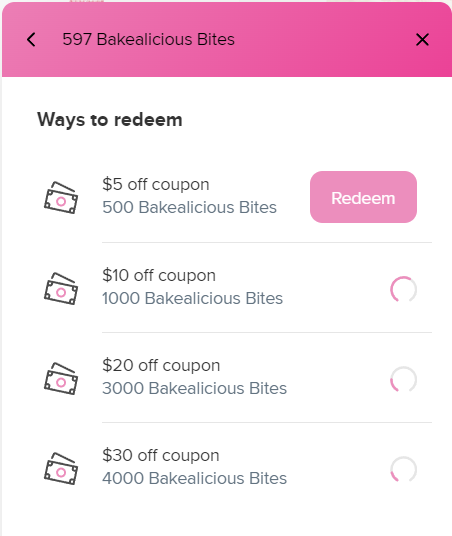
Bakealicious is a Sydney based boutique cake shop which has catered for superstars like Taylor Swift, Harry Styles, and Ed Sheeran. It has won the award for Outstanding Cake Shop on the Northern Beaches in 2023. Nestled in Forestville, it offers an array of freshly baked sweet delights including cupcakes, cakes, and decadent wedding cakes, as well as savoury treats like empanadas and sausage rolls. Bakealicious’ loyalty program is known as Bakealicious Bites and it’s a points based program.
Ways to earn points
Members earn 5 Bakealicious Bites (points) for every $1 spent at Bakealicious.
They can also earn points for signing up as a member, updating their birthday, placing an order, and following their social media accounts.

Ways to redeem points
- 500 Bakealicious Bites equals $5 off credit
- 1000 Bakealicious Bites equals $10 off credit
- 3000 Bakealicious Bites equals $20 off credit
- 4000 Bakealicious Bites equals $30 off credit

Value of rewards
In Bakealicious’ loyalty program, the value per point decreases as more points are earned. Initially, when members earn 500 – 1000 points (which is equivalent to $100 – $200 spent), they receive 5% credit. However, as they accumulate more points, such as 3000 points ($600 spent), they receive 3.33% credit, and at 4000 points ($800 spent), they earn 3.75% credit.
The value of the reward is decreasing as members are spending more money. This means there is no incentive for members to accumulate points. This is the opposite of most loyalty programs which aim to reward loyal members with increasingly valuable rewards. Bakealicious should revisit their loyalty program strategy and their rewards offering as their current credit system makes the program more complicated to understand.
Credit programs
A study by Vana et al (2018)1 found evidence that credit programs increase the probability that consumers will make an additional purchase and increase the size of the spend.
However, a challenge with a credit program is the cost of the credit may need to be greater value than the loyalty currency to excite the member. For instance, offering 5% return on $100 spend in the form of 100 points can work, but a cash equivalent of $5 may not sound valuable enough to motivate the member (Shelper, 2020)2.
Additionally, members may blend the cash reward with their everyday cash and use it to make utilitarian purchases (Kelly et al, 2017)3, which consequently derive little meaning or appreciation (Dunn et al, 2014)4. As these are unmemorable and unemotional transactions, any positive associations between the member and the brand that provided the benefit are lost quickly (Allen et al, 20035; Eisenberger et al, 20016). This is a particularly large risk associated with cashback, credit, and discount loyalty program design frameworks (Shelper, 20207).

Rewards
Alternatively, Bakealicious could offer their members the choice of a free cupcake, mini empanada or sausage roll when they spend a certain amount. For example, members could enjoy one free cupcake per $100 spent. This delicious incentive is complementary to the bakery and its cost-efficient as leftover baked treats are likely available daily. It also avoids any cash outflow from the business. Additionally, it serves as a delightful surprise, bringing joy to the member’s day when they receive it.
Furthermore, Bakealicious’ loyalty program could offer members a complimentary cupcake during their birthday month, enticing them to visit the store and potentially buy their birthday. Similarly, Bakers Delight’s loyalty program known as Dough Getters offer their members a free scone on their birthday.
Lets keep it sweet and simple
Best practice loyalty programs are simple to join, simple to understand, and simple to engage with (Shelper, 2020). While a free cupcake may not seem like a lot at first glance, this simple reward can drive loyalty and foster positive associations with the brand.

Not so sweet thoughts…
Overall, Bakealicious’ loyalty program and the value of their rewards may not be as enticing as their delectable cakes. Their current points system does not adequately reward loyal customers, and credit-based incentives can feel transactional and lack emotional resonance. Instead, offering a free cupcake for every $100 spent will simplify the reward offering and add a sweet touch to the member’s experience, truly making their day.
Want to put sprinkles on your loyalty program?
Our loyalty consultants have helped global brands take the critical steps to design unique and effective loyalty programs, as well as support ongoing evolution to meet changing business and consumer expectations. Contact us to learn more about our comprehensive loyalty services and talk with our loyalty consultants to understand how to develop or optimise your loyalty program strategy.

Reference list
- Vana, Prasad & Lambrecht, Anja & Bertini, Marco, 2018, Cashback Is Cash Forward: Delaying a Discount to Entice Future Spending. Journal of Marketing Research. 55. 852-868. 10.1177/0022243718811853. ↩︎
- Shelper, P. et al., 2020, Loyalty Programs: The Complete Guide . 1st edn. Sydney, NSW: Loyalty & Reward Co. ↩︎
- Kelly, K., Presslee, A. & Webb, A., 2017, ‘The effects of Tangible Rewards Versus Cash in Consecutive Sales Tournaments: A Field Experiment, Accounting Review, Vol 92, Iss 6, cited by Incentive Research Foundation in ‘Award Program Value & Evidence White Paper, 2018, https:// theirf.org/research/award-program-value-evidence-white-paper/2455. ↩︎
- Dunn, E., Aknin, R. & Norton, M., 2014, ‘Prosocial Spending and Happiness Using Money to Benefit Others Pays off’, Current Directions in Psychological Science, Vol 23, Iss 1, pp41-47, cited by Incentive Research Foundation in ‘Award Program Value & Evidence White Paper, 2018, https:// theirf.org/research/award-program-value-evidence-white-paper/2455. ↩︎ ↩︎
- Allen, D., Shore, L. & Griffeth, R, 2003, The Role of Perceived Organizational Support and Supportive Human Resource Practices in the Turnover Process, Journal of Management 29 (1) 99-188, cited by Incentive Research Foundation in ‘Award Program Value & Evidence White Paper, April 2018, accessed via https://theirf.org/research/award-program-value-evidence-white-paper/2455/ ↩︎
- Eisenburger R, Armeli S, Rexwinkel B, Lynch P, Rhoades L. Reciprocation of Perceived Organizational Support, Journal Applied Psychology, 2001, cited by Incentive Research Foundation in ‘Award Program Value & Evidence White Paper, April 2018, accessed via https://theirf.org/research/award-program-value-evidence-white-paper/2455/ ↩︎

